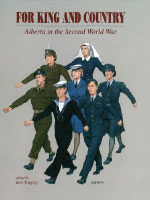Community in Transition: Red Deer in the Second World War
Michael Dawe
Reprinted with permission of the author and publisher of For King and Country: Alberta in the Second World War In the twenty years following the end of the Great War of 1914-1918, central Alberta experienced a long series of troubles. The immediate post-war period was marked by high inflation and the widespread 'flu epidemic. Then came a deep depression and an extensive drought. While the late 1920s brought a brief promise of prosperity, the community soon found itself in the depths of another great depression. Only as the 1930s drew to a close did the long siege of economic hardships finally seem to be lifting.
In the twenty years following the end of the Great War of 1914-1918, central Alberta experienced a long series of troubles. The immediate post-war period was marked by high inflation and the widespread 'flu epidemic. Then came a deep depression and an extensive drought. While the late 1920s brought a brief promise of prosperity, the community soon found itself in the depths of another great depression. Only as the 1930s drew to a close did the long siege of economic hardships finally seem to be lifting.
Ironically, as the hard times came to an end the era of peace drew to a close as well. In the newspapers and on the radio, the people learned of the gathering storm clouds of war in Europe. On 3 September 1939 the expected and feared event finally happened. Great Britain declared war on Germany after the latter invaded Poland, and one week later Canada joined the hostilities. For the second time in 25 years another terrible global conflict had broken out. Red Deer would never be the same again.
A flurry of activity followed the declaration of war as the military authorities ordered a complete mobilization of the Canadian Army Active Force. Almost immediately, a dozen men from the militia's 78th Field Battery Royal Canadian Artillery [RCA] left Red Deer for Esquimalt, British Columbia, where they joined the coastal defence artillery.
It was decided not to bring the local 78th Battery RCA up to full war strength. Instead recruitment commenced at the Red Deer Armoury for an Edmonton unit, the 92nd Battery RCA. As had been the case at the start of the First World War, the local men quickly responded to the new call to arms. On 11 September 1939, the day after war was officially declared by Canada, thirty men left Red Deer to train with the 92nd Battery RCA. A week later, another 24 followed them to Edmonton. A number of others also left to enlist with Calgary units such as the 23rd Battery RCA and the Calgary Highlanders.
As the military got its plans of action under way, work was also begun to organize the "home front." On 21 September 1939 more than 130 people turned out to reorganize the moribund Red Deer Branch of the Canadian Red Cross. A fund-raising drive was initiated and more than fifteen hundred dollars was soon raised. In a community which had suffered years of economic hardships, the pocket books had been quickly opened.
By mid-October, the pace of recruitment began to slacken. Most of the units which were to make up the First Canadian Division had met their quotas, and the military authorities had no immediate plans to mobilize new units. In a speech made in Red Deer, Brigadier George Pearkes explained that the intention was to train troops in Canada thoroughly before sending them overseas. He added that the authorities felt it was more efficient to handle the recruits in batches rather than in a continual stream.1
This apparent lack of urgency was reinforced by the unusual quiet along the several fronts during the "phoney war." There were a few skirmishes, air raids and submarine attacks. However, most military leaders expected the same static style of warfare as had existed in the First World War. They consequently directed most of their attention to preparing defences and building the strengths of their fighting forces rather than launching offensives.
During the lull political conflicts moved to the forefront. By early 1940, there was growing criticism of the Federal Government's conduct of the war. As a result, Prime Minister Mackenzie King called a federal election to secure a new mandate. Alberta's Premier Aberhart cunningly called a provincial election for the same time. The Liberals and Conservatives who had joined forces in the antisocial Credit "Unity" movement now found themselves in the awkward position of campaigning against the Aberhart government in the provincial contest and against each other in the federal election.
Across the province, Premier Aberhart's strategy worked well. The Social Credit government was returned, albeit with a much-reduced majority. In Red Deer, however, anti-Social Credit feelings were strong. Alfred Speakman, the former United Farmers of Alberta [UFA] Member of Parliament, and now an Independent, was elected by a comfortable margin. In the federal election five days later the Social Credit candidate F.D. Shaw won the riding. Nevertheless, in the City of Red Deer, Shaw finished third behind the Liberals and Conservatives.
Ironically, two weeks after Prime Minister Mackenzie King received the electoral endorsement of his policies of caution and restraint, the war changed dramatically. The Germans launched their stunning "Blitzkrieg" offensive, and the great defences of the Western Front collapsed. By the late spring of 1940 Great Britain and its Commonwealth allies were left to fight on alone against the victorious German forces.
Almost immediately, new enlistment drives were commenced across Canada. The 78th Battery RCA was ordered to mobilize at once as part of a new active service unit with the 22nd Battery RCA from Gleichen, Alberta. In two days, more than forty recruits reported at the Red Deer Armoury. Within two weeks 150 men had enlisted in the artillery.
Shortly thereafter, the military authorities announced that a company of the Calgary Regiment [Tank] would be raised in Red Deer. In one day, more than seventy men volunteered to join the unit. The company quickly met its quota of 150 men.
Manpower was not only needed for military service. Crews were hired to start work on an expansion of the Penhold airport, which had been built south of Red Deer in the late 1930s. The airfield had been chosen as a training base under the British Commonwealth Air Training Plan, a joint programme of Canada, Great Britain, Australia and New Zealand. With the crisis in Europe deepening each day, plans were accelerated and the construction work was pushed forward at a frenetic pace.
Despite these initiatives there was a widespread feeling that not enough was being done for the war. The Red Deer Board of Trade held a special meeting in June 1940, and passed five resolutions demanding more speed and vigour in the war effort, the internment of all subversives, registration of foreigners, conscription of manpower and wealth, and more stringent regulations in the sale of firearms and explosives. Plans were also made to hold a massive public meeting which would demand more action from the government.2
Notes
1. Red Deer Advocate, 27 September 1939.
2. Red Deer Advocate, 17 June 1940.








